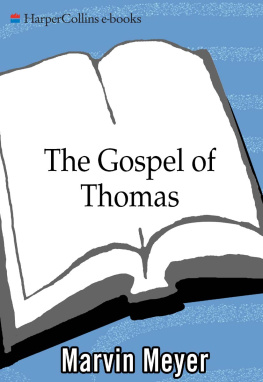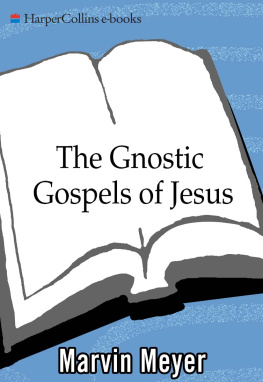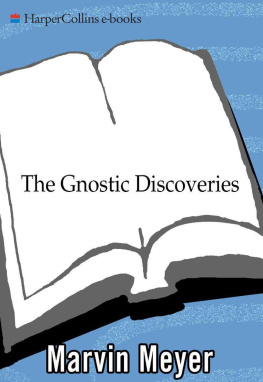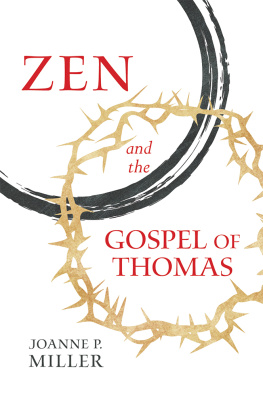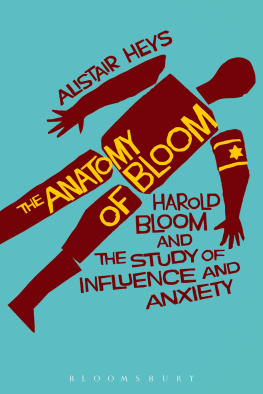Marvin W. Meyer - The Gospel of Thomas: The Hidden Sayings of Jesus
Here you can read online Marvin W. Meyer - The Gospel of Thomas: The Hidden Sayings of Jesus full text of the book (entire story) in english for free. Download pdf and epub, get meaning, cover and reviews about this ebook. year: 2009, publisher: HarperCollins, genre: Religion. Description of the work, (preface) as well as reviews are available. Best literature library LitArk.com created for fans of good reading and offers a wide selection of genres:
Romance novel
Science fiction
Adventure
Detective
Science
History
Home and family
Prose
Art
Politics
Computer
Non-fiction
Religion
Business
Children
Humor
Choose a favorite category and find really read worthwhile books. Enjoy immersion in the world of imagination, feel the emotions of the characters or learn something new for yourself, make an fascinating discovery.
- Book:The Gospel of Thomas: The Hidden Sayings of Jesus
- Author:
- Publisher:HarperCollins
- Genre:
- Year:2009
- Rating:3 / 5
- Favourites:Add to favourites
- Your mark:
- 60
- 1
- 2
- 3
- 4
- 5
The Gospel of Thomas: The Hidden Sayings of Jesus: summary, description and annotation
We offer to read an annotation, description, summary or preface (depends on what the author of the book "The Gospel of Thomas: The Hidden Sayings of Jesus" wrote himself). If you haven't found the necessary information about the book — write in the comments, we will try to find it.
A fresh, authoritative English translation, with an informative introduction, fascinating explanatory notes, and the Coptic text, with interpretation by Harold Bloom, our pre-eminent literary critic.
The Gospel of Thomas: The Hidden Sayings of Jesus — read online for free the complete book (whole text) full work
Below is the text of the book, divided by pages. System saving the place of the last page read, allows you to conveniently read the book "The Gospel of Thomas: The Hidden Sayings of Jesus" online for free, without having to search again every time where you left off. Put a bookmark, and you can go to the page where you finished reading at any time.
Font size:
Interval:
Bookmark:
The Gospel of Thomas
The Nag Hammadi Scriptures
The Gospels of Mary
The Gnostic Gospels of Jesus
The Gnostic Discoveries
Judas
The Hidden Sayings of Jesus

To Elisabeth
I wish to express my appreciation to several people and organizations who have helped make this book a reality. I thank Gawdat Gabra, Girgis Daoud Girgis, and Samiha Abd El Shaheed of the Coptic Museum for their kindness in allowing me access to the Coptic pages of the Gospel of Thomas. I acknowledge the generous support of the National Endowment for the Humanities, the Graves Awards Committee (for the American Council of Learned Societies), and the Griset Chair in Bible and Christian Studies at Chapman University. I appreciate very much the provocative and literate essay contributed by Harold Bloom, the eminent literary critic and student of ancient and modern gn sis. I am grateful to Jonathan Reed of the University of La Verne for computer assistance in preparing the Coptic text for press. I also would like to thank a number of people at Chapman University and Harper San Francisco for their help in moving this project along, especially my editor, John Loudon, who invited me to put together this volume and worked closely with me to assure an uncompromising blend of scholarship and accessibility. Finally, I owe much to the continuing patience and support of my wife and children. It is to my daughter, who already has taught me a great deal about wisdom, that I dedicate this book.
sis. I am grateful to Jonathan Reed of the University of La Verne for computer assistance in preparing the Coptic text for press. I also would like to thank a number of people at Chapman University and Harper San Francisco for their help in moving this project along, especially my editor, John Loudon, who invited me to put together this volume and worked closely with me to assure an uncompromising blend of scholarship and accessibility. Finally, I owe much to the continuing patience and support of my wife and children. It is to my daughter, who already has taught me a great deal about wisdom, that I dedicate this book.
Marvin Meyer
Chapman University
The Gospel according to Thomas is an ancient collection of sayings of Jesus said to have been recorded by Judas Thomas the Twin. Unlike other early Christian gospels, which typically consist of narrative accounts interpreting the life of Jesus of Nazareth and culminating in descriptions of his death, the Gospel of Thomas focuses specifically upon sayings of Jesus. The document claims that these sayings themselves, when properly understood, communicate salvation and life: Whoever discovers the interpretation of these sayings will not taste death (saying 1).
The Coptic text of the Gospel of Thomas came to light with the discovery of the Nag Hammadi library, within which the Gospel of Thomas is to be found as the second tractate, or document, of Codex II. According to Muhammad Ali of the al-Samman clan, who has told his story to James M. Robinson, this remarkable manuscript discovery took place around December 1945.
At that time (so the story goes), several Egyptian fellahin, including Muhammad Ali, were riding their camels near the Jabal al-Tarif, a huge cliff that flanks the Nile River in Upper Egypt not far from the modern city of Nag Hammadi. They were looking for sabakh, a natural fertilizer that accumulates in the area, and so they hobbled their camels at the foot of the Jabal al-Tarif and began to dig around a large boulder that had fallen onto the talus, or slope of debris against the cliff face. Much to their surprise, they uncovered a large storage jar with a bowl sealed on top of it as a lid. Muhammad Ali hesitated before opening the sealed jar. Apparently he feared that the jar could contain a jinn, or spirit, that might be released to haunt him and do mischief. Yet he also reflected upon the legends concerning treasures hidden in the area, and his love of gold overcame his fear of jinns. He smashed the jar with his mattock, and as he has explained it, a golden substance flew out of the jar and disappeared into the air.
As we demythologize his story, we conclude that what he saw was probably neither a jinn nor gold, but rather papyrus fragments that were golden in color and that glistened in the sunlight. For he had discovered the thirteen papyrus books (codices) of the Nag Hammadi library, and the Gospel of Thomas within the library.
Prior to this manuscript discovery, scholars knew of scattered statements in the church fathers referring to a document called the Gospel of Thomas. We suspect that some of these testimonies may well refer to the Infancy Gospel of Thomas, an early Christian document that presents a series of legendary tales about the miraculous feats of the child Jesus. Other testimonies suggest that a Gospel of Thomas was used or even written by the Manichaeans, who were mystical, gnostic followers of the teacher Mani. In his Catechesis 6.31, Cyril of Jerusalem claims that the Thomas who wrote the Gospel of Thomas was not one of the followers of Jesus but instead a wicked follower of Mani. The fairly extensive parallels between the Gospel of Thomas from the Nag Hammadi library and Manichaean literature may substantiate that there was a connection between the Nag Hammadi Gospel and a gospel in use among the Manichaeans.
Other testimonies in the church fathers refer more obviously to elements in the Gospel of Thomas from the Nag Hammadi library. The most secure of these references occurs in the third-century author Hippolytus of Rome. In his Refutation of All Heresies 5.7.2021, he cites a statement from a Gospel of Thomas that was in use among the Naassene gnostics and that bears considerable similarity to part of Gospel of Thomas saying 4. The passage in Hippolytus reads as follows:
not only the mysteries of the Assyrians and the Phrygians , they say, bear witness to their doctrine about the blessed nature, both hidden and revealed, of what has been and is and is yet to be, which, he says, is kingdom of heaven within humankind that is sought, concerning which they explicitly teach in the Gospel entitled According to Thomas, saying thus, One who seeks will find me in children from seven years, for there, hidden in the fourteenth age, I am revealed. And this comes not from Christ but from Hippocrates, saying, A child of seven years is half a father. Hence, having placed the generative nature of all in the generative seed, and having heard the Hippocratic (saying) that a child of seven years is half a father, they say that one is revealed at four years according to Thomas. This is the unutterable and mystical doctrine they have.
Later, in Refutation 5.8.32, Hippolytus quotes another Naassene statement that is not explicitly said to derive from the Gospel of Thomas but resembles a portion of Thomas saying 11: So they say, If you ate dead things and made them living, what will you do if you eat living things?
In addition to these testimonies in the church fathers, three Greek papyri found in a rubbish heap at Oxyrhynchus (modern Bahnasa, Egypt) and published in 1897 and 1904 may also be linked to the Gospel of Thomas. These three papyri, Papyrus Oxyrhynchus 1, 654, and 655, all contain sayings of Jesus. Papyrus Oxyrhynchus 654.13 provides an incipit, or opening of the text, that is nearly identical to the prologue of the Nag Hammadi Gospel of Thomas: These are the [hidden] sayings [that] the living Jesus spoke [and Judas, who is] also (called) Thomas, [recorded]. Other sayings contained in these three papyri parallel Gospel of Thomas sayings 17, 24, 2633, 3639, and 77. When he published The Sayings of Jesus from Oxyrhynchus in 1920, Hugh G. Evelyn-White conjectured that these sayings in the Oxyrhynchus papyri may come from the Gospel of Thomas, the Gospel of the Egyptians, or the Gospel of the Hebrews. Now that we know of the Gospel of Thomas from the Nag Hammadi library, we can appreciate how insightful Evelyn-Whites observations were: The Oxyrhynchus papyri represent Greek editions of the Gospel of Thomas.
As a collection of sayings of Jesus, the Gospel of Thomas is closer in genre to other ancient collections of sayings than to the New Testament gospels. In the ancient world, Jewish, Greco-Roman, and Christian collections of sayings circulated widely. Sayings are particularly prominent in Jewish wisdom literature. Jewish sages compiled documents like Proverbs, Ecclesiastes, the Wisdom of Solomon, and Sirach, as well as the tractate Pirke Aboth (Sayings of the Fathers), which was included within the Mishnah. These documents belong to an exceedingly old tradition of wisdom literature in Egypt and the ancient Middle East, a tradition that extends back to the second and third millennia B.C.E . with such collections as those of Amenemhat, Amenemope, Ptahhotep, Shuruppak, and Ahikar. The Jewish wisdom texts commonly personify Wisdom as a female character (the Hebrew and Greek words for wisdom, hokhmah and sophia, are both feminine) who comes from God and speaks forth in proverbs, riddles, and other sagacious sayings (see Proverbs 8:136).
Font size:
Interval:
Bookmark:
Similar books «The Gospel of Thomas: The Hidden Sayings of Jesus»
Look at similar books to The Gospel of Thomas: The Hidden Sayings of Jesus. We have selected literature similar in name and meaning in the hope of providing readers with more options to find new, interesting, not yet read works.
Discussion, reviews of the book The Gospel of Thomas: The Hidden Sayings of Jesus and just readers' own opinions. Leave your comments, write what you think about the work, its meaning or the main characters. Specify what exactly you liked and what you didn't like, and why you think so.

